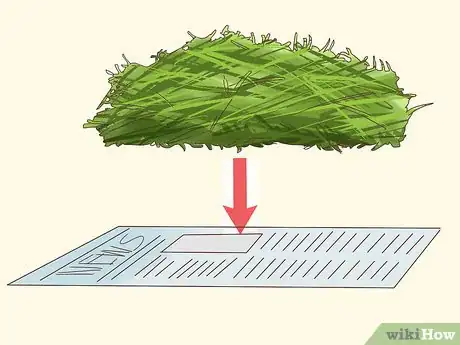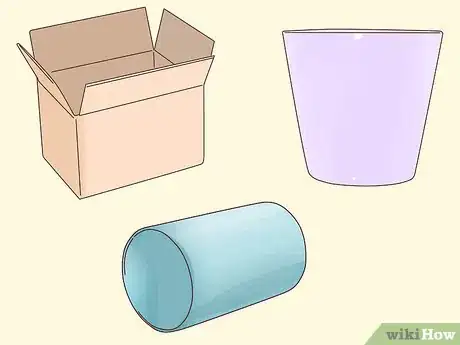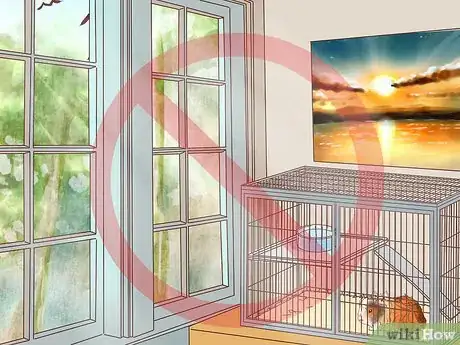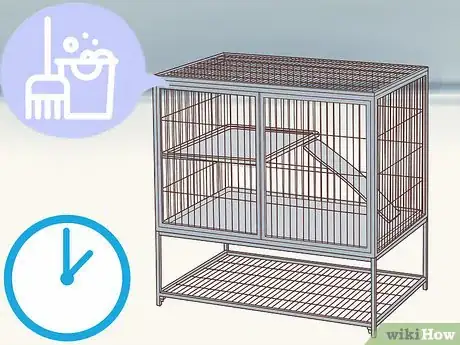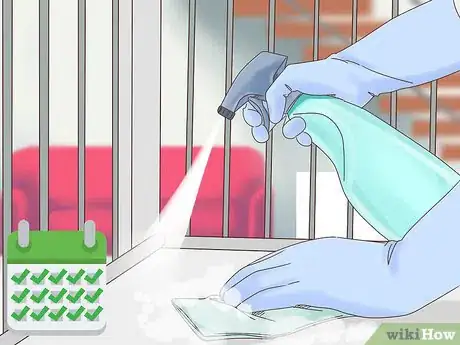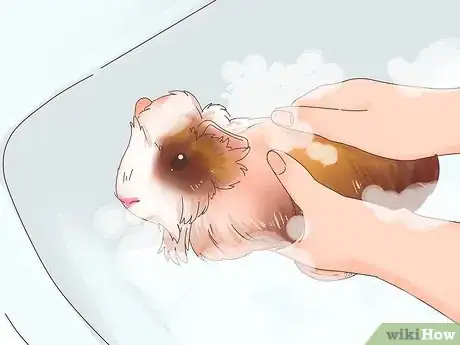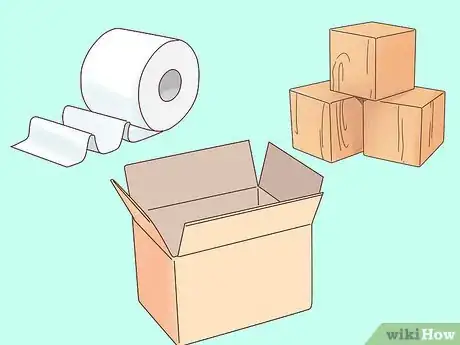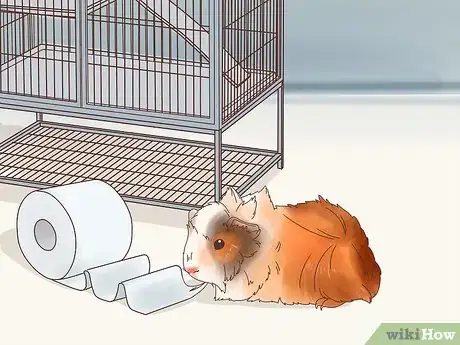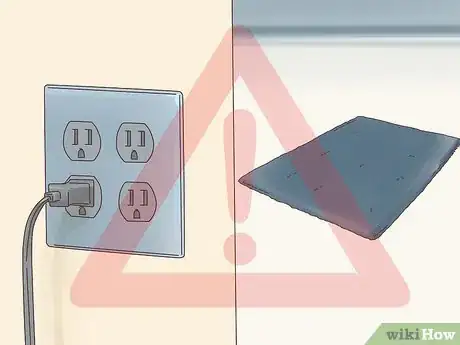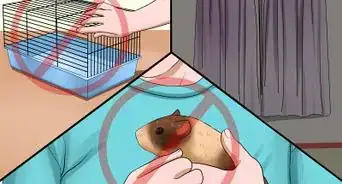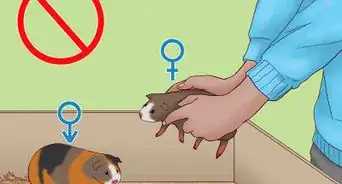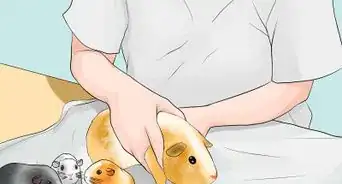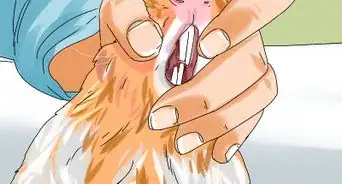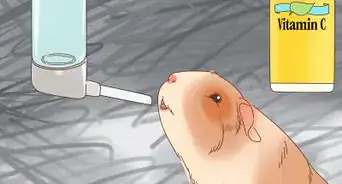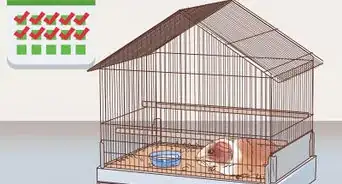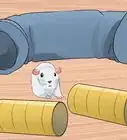This article was co-authored by Pippa Elliott, MRCVS. Dr. Elliott, BVMS, MRCVS is a veterinarian with over 30 years of experience in veterinary surgery and companion animal practice. She graduated from the University of Glasgow in 1987 with a degree in veterinary medicine and surgery. She has worked at the same animal clinic in her hometown for over 20 years.
There are 13 references cited in this article, which can be found at the bottom of the page.
wikiHow marks an article as reader-approved once it receives enough positive feedback. In this case, 85% of readers who voted found the article helpful, earning it our reader-approved status.
This article has been viewed 29,760 times.
With their tufted coats and spunky personalities, Abyssinian guinea pigs make excellent companions. While they’re easy to care for, they’re a little higher maintenance than other guinea pig breeds. [1] They’re social and have lots of energy, so your Abby will need a big cage and lots of playtime. They’re prone to obesity-related diseases, so a well-balanced diet is vital. While your Abby will handle most of its grooming, brushing it every other day will reinforce your bond and prevent tangles.
Steps
Providing the Best Habitat
-
1House your Abyssinian in the largest possible cage. House your pet in the largest cage that your living space and budget can accommodate. Abyssinians are known for their high energy, so they need plenty of space for exercise.[2] A good size for one guinea pig is about 7 square feet (0.65 square meters), or 30 by 36 inches (76 by 91 cm).[3]
- Many cages advertised for guinea pigs are around 2 square feet, which is too small for an active Abyssinian.
- Don’t use a glass aquarium or a cage with a wire bottom. Glass aquariums don’t allow enough air flow, and wire bottoms can injure a guinea pig’s feet and legs.
-
2Cover the bottom of the cage with soft bedding. Commercial paper bedding is popular and controls odor. While it doesn’t control odor, Timothy hay is a good option, since guinea pigs love to tunnel through and eat it. For the best of both worlds, use paper bedding for the base layer and hay for the top.
- Stay away from wood shavings, straw, and cat litter, which can each cause injuries or health problems.
Advertisement -
3Place a hide area in its cage. A dark hide area will offer your guinea pig a place to rest and help prevent stress. You can find a hide box online or at your local pet store. You could also just use a cardboard box, a flower pot, or a large PVC tube.[4]
- If you have more than one guinea pig, then make sure that each animal has its own hideaway.
-
4Keep the cage away from drafts and direct heat sources. Like all guinea pigs, Abyssinians are prone to overheating, so keep the cage away from fireplaces, sunlit windows, and other sources of direct heat. They prefer temperatures between 65 to 75 degrees Fahrenheit (18 to 24 degrees Celsius), so keep the cage away from unheated, drafty areas, too.[5]
- Abyssinians are especially social and like to be around their owners, so the family room is a good cage location. However, they have sensitive hearing, so keep the cage away from televisions, speakers, and other sources of loud noise.
Feeding Your Abyssinian
-
1Keep clean water in its cage at all times. Your Abby should always have access to clean fresh water in a bowl or stoppered bottle container. It will probably like to play and sit in a water bowl, so you’ll need to change the water several times a day.[6]
- A stoppered bottle won’t need to be changed as frequently. Its spout should be metal so your Abby can’t chew through it.
-
2Provide a constant supply of grass hay. Timothy, orchard, or brome hay is the most important part of your pet’s diet. Hay provides the fiber a guinea pig needs and helps wear down its teeth.[7]
- Go for grass hay instead of legume hay, such as alfalfa, which contains too much protein and calcium and can lead to obesity.
-
3Feed your Abby guinea pig pellets in moderation. Guinea pig pellets provide needed vitamins and minerals, but a constant supply can lead to obesity. Abyssinians are prone to obesity-related diseases, such as diabetes, so you should only provide a small daily portion.[8]
- A good portion size is 1/8 cup (30 mL) of pellets per 2 pounds (0.9 kg) of weight.[9]
-
4Provide a small portion of fresh fruits or veggies. Washed fruits or veggies will keep your guinea pig’s diet well-rounded and help prevent it from getting bored with its food. Good choices include kale, mustard and collard greens, grapes, kiwis, and oranges. Serve 1/2 to 1 cup (120 to 240 mL) each day, and remove uneaten portions within a few hours to prevent bacterial growth.[10]
- Guinea pigs usually don’t like cold food, so give it fruits and veggies at room temperature.[11]
- Don’t feed your pet iceberg lettuce, nuts or seeds with shells, dairy products, and candy.
-
5Make sure it gets enough vitamin C. Like all other breeds, Abyssinian guinea pigs need to consume lots of vitamin C.[12] Feeding it pellets fortified with vitamin C and daily portions of fresh fruits and veggies will help meet its nutritional needs.
- You can also purchase chewable vitamin C tablets for guinea pigs or supplements that dissolve in water.[13]
Keeping Cleaning and Grooming Routines
-
1Give the cage a daily spot cleaning. Transfer your pet to a spare cage or safe spot, then scoop out droppings, remove uneaten food, and replace soiled bedding. Wash the food and water containers with hot, soapy water, and rinse them well before refilling them.[14]
- When you do your daily spot cleaning, check for potential hazards and damage to the cage. Check the droppings for signs of illness, such as diarrhea.
- Wear latex or rubber gloves, use cleaning supplies designated for cage cleaning only, and wash your hands when you’re finished.
-
2Give the cage a weekly deep cleaning. Take everything out of the cage and throw away all of the old bedding. Clean the cage with hot, soapy water, and use a scrub pad or old toothbrush to remove any stubborn deposits from the bars and floor. Use a store-bought disinfectant or a mild bleach solution to sanitize the cage, toys, and food and water containers.[15]
- Rinse the cage and accessories thoroughly with hot water after disinfecting them.
- Let everything dry completely, then add fresh bedding and put the cage back together.
-
3Brush your Abyssinian every other day. While they’re considered short-haired guinea pigs, Abyssinians have a unique tufted coat that requires some maintenance. Use a soft bristle brush or toothbrush to groom your pet to prevent tangles. Brush outward from the centers of the tufted rosettes on its shoulders, back, and hindquarters.
- Pay particular attention to the rear end, which is especially prone to matting and compacted droppings.[16] If your guinea pig has a tendency to get matted fur on its rear, trim the fur shorter in that area. You can do it yourself or ask your vet to help you.
-
4Bathe your guinea pig only when necessary. Abyssinians handle most of their grooming themselves, and they prefer their own scent to that of cleaning products. However, your pet won’t be happy if its beautiful coat gets messy or sticky, so an occasional bath might be necessary.[17]
- Fill a basin with about an inch (two to three cm) of warm water, then place your guinea pig in the basin. Give it a minute to adjust, and pet it and offer treats so it knows it’s safe.
- Wet its fur with your hands, but take care to avoid its face and ears. Gently massage it with shampoo labelled for guinea pigs, then rinse away all soapy residue with running warm water.
- Towel dry your guinea pig and brush its fur to prevent matting.
Playing With Your Pet
-
1Give your pet chew toys and chew sticks. Like other guinea pigs breeds, Abyssinians need to chew in order to wear down their teeth, which grow constantly. Chew sticks and chew toys, cardboard boxes, paper towel rolls, and untreated wood or wicker are all great options.[18]
- Keep backups handy so you can replace destroyed toys when necessary.
-
2Let your guinea pig play outside of its cage under supervision. All guinea pigs are social animals, but Abyssinians love to be with their owners even more than other breeds. In addition to meeting its social needs, daily out of cage time will give your active Abby exercise. Always supervise your pet closely when it’s out of its cage, and make sure the room is secure and guinea pig proof.[19]
-
3Make sure the out of cage play area is guinea pig proof. Abyssinians are notoriously mischievous, so you’ll need to make sure it can’t get into any trouble during out of cage playtime. Keep it away from electrical cords, rugs, or other objects that might tempt it to chew. Make sure it can’t get under sofas or beds, into vents, or any other places where it might get lost.[22]
- Keep other pets away during out of cage time, and supervise children when they interact with your guinea pig.
-
4Get your Abyssinian a companion. Your super social Abby will be happier if it has a playmate, especially if you can’t spend lots of quality time with it. Caring for multiple guinea pigs isn’t too much more demanding than owning just one. The most important thing is to provide a large enough enclosure.[23]
- Believe it or not, it’s illegal to own just one guinea pig in Switzerland![24]
References
- ↑ https://www.petsradar.com/features/five-popular-guinea-pig-breeds
- ↑ http://www.guineapighub.com/abyssinian-guinea-pig/
- ↑ http://www.humanesociety.org/animals/guinea_pigs/tips/guinea_pig_housing.html
- ↑ http://petguineapigcare.com/cage-habitat/
- ↑ http://www.humanesociety.org/animals/guinea_pigs/tips/guinea_pig_housing.html
- ↑ http://petguineapigcare.com/cage-habitat/
- ↑ https://www.texvetpets.org/article/owning-guinea-pigs/
- ↑ https://abyssinianguineapigtips.com/all-about-abyssinian-guinea-pig/
- ↑ http://www.cpr-nc.org/pet-care-info/guinea-pigs
- ↑ http://www.cpr-nc.org/pet-care-info/guinea-pigs
- ↑ http://petguineapigcare.com/food-diet/
- ↑ https://abyssinianguineapigtips.com/all-about-abyssinian-guinea-pig/
- ↑ http://www.cpr-nc.org/pet-care-info/guinea-pigs
- ↑ http://www.peteducation.com/article.cfm?c=18+1798&aid=3579
- ↑ http://www.peteducation.com/article.cfm?c=18+1798&aid=3579
- ↑ https://pethelpful.com/rodents/The-Abyssinian-Guinea-Pig
- ↑ https://pethelpful.com/rodents/The-Abyssinian-Guinea-Pig
- ↑ http://www.cpr-nc.org/pet-care-info/guinea-pigs
- ↑ https://www.texvetpets.org/article/owning-guinea-pigs/
- ↑ https://abyssinianguineapigtips.com/all-about-abyssinian-guinea-pig/
- ↑ https://www.thespruce.com/product-guinea-pigs-must-have-2662211
- ↑ https://www.texvetpets.org/article/owning-guinea-pigs/
- ↑ https://abyssinianguineapigtips.com/why-you-should-have-2-guinea-pigs/
- ↑ https://www.dvm360.com/view/swiss-law-orders-pet-buddy-system
About This Article
To care for your Abyssinian guinea pig, feed it a constant supply of timothy, orchard, or brome hay, which provides the fiber your guinea pig needs. Add fresh fruits and vegetables, like kale, mustard greens, grapes, and oranges, along with pellets reinforced with vitamin C, to give your guinea pig the nutrients it needs. Additionally, give your guinea pig chew toys, paper towel rolls, wicker, or cardboard boxes for it to chew on in order to wear down its teeth, which grow constantly. To make sure your guinea pig gets enough exercise, let your it play outside of its cage under supervision every day. Also, brush your guinea pig every other day to prevent tangles. For more tips from our Veterinary co-author, like how to set up the best habitat for your guinea pig, keep reading!

